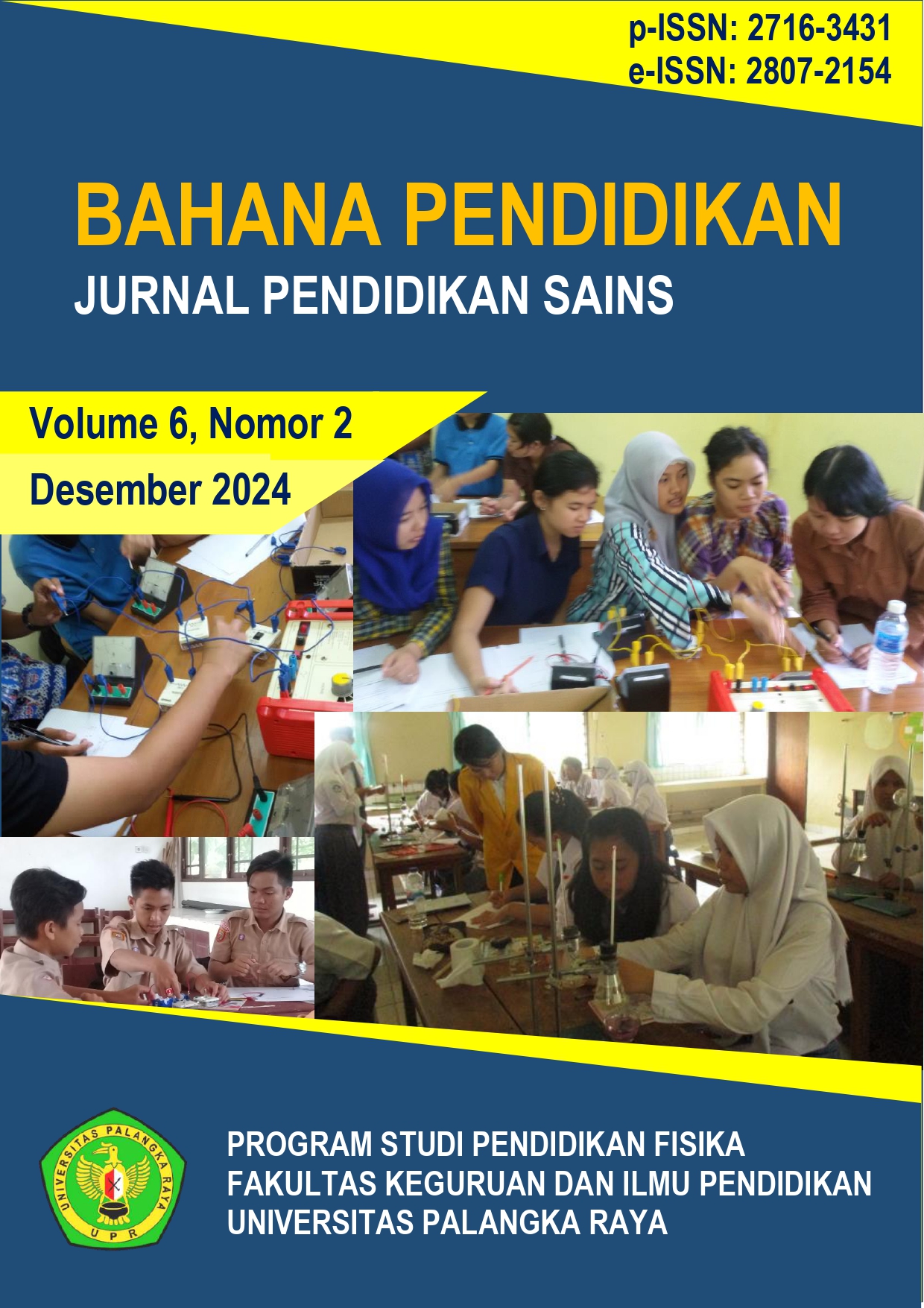Model Pembelajaran Problem Solving pada Materi Getaran dan Gelombang untuk Melatih Keterampilan Proses Sains di Kelas VIII SMP
DOI:
https://doi.org/10.37304/bpjps.v6i2.15108Keywords:
Model pembelajaran problem solving, keterampilan proses sains, Hasil BelajarAbstract
Abstrak – Model Problem Solving adalah model yang mengutamakan pemecahan masalah dalam kegiatan belajar untuk memperkuat daya nalar yang digunakan oleh peserta didik agar mendapatkan pemahaman yang lebih mendasar dari materi yang disampaikan. Tujuan penelitian ini adalah untuk mengetahui (1) keterampilan proses sains peserta didik setelah dilatih dengan model pembelajaran Problem Solving pada materi getaran dan gelombang. (2) ketuntasan hasil belajar kognitif yang dicapai siswa setelah menerapkan model pembelajaran Problem Solving pada materi getaran dan gelombang. Penelitian ini merupakan penelitian pre-experimental menggunakan desain One Shot Case Study. Populasi dalam penelitian ini adalah kelas VIII SMP di Kota Palangkaraya Tahun Ajaran 2023/2024. Sampel penelitian ini dipilih secara random sampling, dimana kelas yang terpilih adalah kelas VIII-3 dengan jumlah 32 siswa. Instrumen yang digunakan dalam penelitian ini adalah tes keterampilan proses sains dan tes hasil belajar kognitif. Hasil uji coba tes hasil belajar kognitif dari 40 soal, diperoleh 10 soal gugur. Jadi soal THB yang digunakan adalah sebanyak 30 soal dengan reliabilitas 0,95. Hasil analisis data menunjukkan bahwa keterampilan proses sains dari 30 siswa yang mengikuti tes diperoleh 6 siswa (20%) dengan kategori sangat baik, 18 siswa (60%) dengan kategori baik dan 6 siswa (20%) dengan kategori cukup baik. Hasil belajar kognitif individu dari 30 siswa yang mengikuti tes diperoleh 23 siswa tuntas dan 7 siswa tidak tuntas. Secara klasikal ketuntasan sebesar 76,67% melebihi standar ketuntasan klasikal yaitu ≥75%. Ketuntasan TPK pada materi getaran dan gelombang dari 30 TPK diperoleh 24 (80%) TPK tuntas dan 6 (20%) TPK tidak tuntas. Hasil ini menunjukkan bahwa model pembelajaran yang diterapkan dapat memfasilitasi keterampilan proses sains siswa dan mencapai hasil belajar yang ditargetkan.
Abstract – The Problem Solving Model is a model that prioritizes problem solving in learning activities to strengthen the reasoning power used by students to gain a more basic understanding of the material presented. The purpose of this research is to determine (1) students' science process skills after being trained with the Problem Solving learning model on vibration and wave material. (2) the completeness of cognitive learning outcomes achieved by students after applying the Problem Solving learning model to vibration and wave material. This research is pre-experimental research using a One Shot Case Study design. The population in this study was class VIII of SMP in Palangkaraya City for the 2023/2024 academic year. The sample for this research was chosen by random sampling, where the selected class was class VIII-3 with a total of 32 students. The instruments used in this research were science process skills tests and cognitive learning outcomes tests. The results of the cognitive learning outcomes test trial of 40 questions resulted in 10 failed questions. So the THB questions used were 30 questions with a reliability of 0.95. The results of data analysis show that the science process skills of the 30 students who took the test were obtained by 6 students (20%) in the very good category, 18 students (60%) in the good category and 6 students (20%) in the quite good category. The individual cognitive learning results of the 30 students who took the test showed that 23 students completed and 7 students did not complete. Classically, the completeness level is 76.67%, exceeding the classical completeness standard, which is ≥75%. Completion of TPK on vibration and wave material from 30 TPK obtained 24 (80%) TPK complete and 6 (20%) TPK incomplete. These results shows that the implemented learning model can facilitate students’ science process skill and achieve the determined learning results.
Downloads
Downloads
Published
How to Cite
Issue
Section
License
Copyright (c) 2025 Maisya Dwi Saputri, Muhammad Nawir, Suhartono

This work is licensed under a Creative Commons Attribution 4.0 International License.
DPR KONTOL DPR PEPEK








